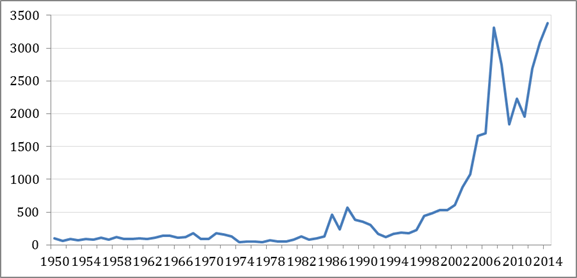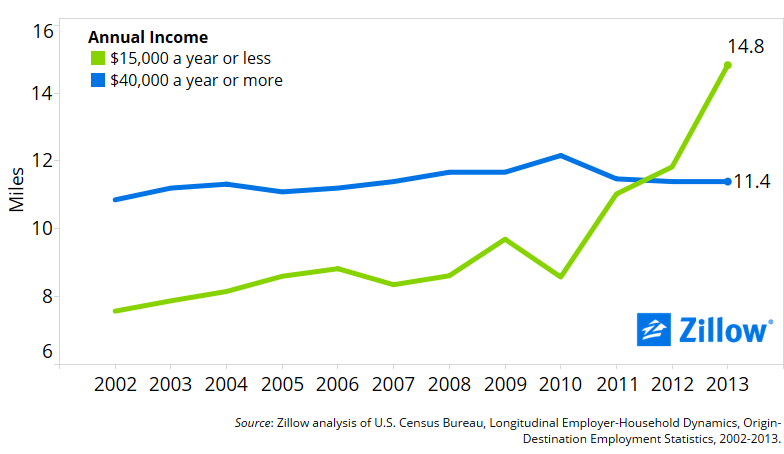This is what happens to places where the rich want to live, under an oligarchy:

Inflation Adjusted Manhattan Real Estate Prices
Yee-ha!
Yeah. I dunno. I could write a bunch of stuff, but the chart kind of speaks for itself, doesn’t it?
(I am fundraising to determine how much I’ll write this year. If you value my writing, and want more of it, please consider donating.)
More recent, but also striking, is this chart, on commute distance in San Francisco:

San Francisco Commute Distance
This, by the way, is why the idea that countries like the US and the core European countries can’t tax people is bullshit.
There just aren’t that many cities rich people want to live in, and for Western elites, they are essentially all in Western Europe or the US (maybe Canada, in a pinch). They want to live in your country, or do business there? Then you can tax them. This is especially true of the US, Britain (London), and France (Paris, south of France).
As for the peons, let them live in Detroit. Or Flint, wherever Flint is, in the scabrous country beyond where people who matter live.

Erin Gannon
I’ve invented a word for this (cause it’s not really gentrification): Emptification.
ekstase
The funny thing is, they perennially use artists to “regentrify” neighborhoods and cities, because money isn’t cool without them. Then they price artists out and somewhere else becomes cool. As soon as you’ve got charts like the ones above, it’s kinda over. Apparently, our souls don’t fare well in Plastic-ville.
Kim Kaufman
I’m lucky I grew up there back in the day when there was a middle class. I’m watching Los Angeles become the place with no affordable housing.
Mary McCurnin
My 41 year old daughter lives in Marin County. She is an acupuncturist and her partner is a chef. They are in big trouble financially. $2150 a month for rent and the apartment is in terrible condition and very small. $1000 for health insurance. Another $1000 for childcare. She calls her lifestyle “Circling The Drain”.
We are considering moving into a big house together in a “cheaper” part of the area like Richmond or Benicia. We would rent a house for around $2800 to $3200 a month.
How long can this continue? It just doesn’t seem sustainable. We are actually thinking about moving to New Orleans since that is where I am from and we have family there. But it is being gentrified at a pretty fast clip, too. It will never be as expensive as CA but it is changing.
Is there any hope for a sustainable, less stressful life? Are we all headed towards living like the people in India or China?
Mary McCurnin
or should we move to Costa Rica? (really)
Erasmus
I made up a word, too, for Toronto: “facade-a-minium”. Here, we keep the working class facades, (including churches and rowhouses) and build the glass towers into their gutted facade. I tried it out on a couple of white helmeted engineers, who approved it instantly.
I started thinking of it like Mumbai, where the rich live up in the starwars high clouds, (with their own vegan sky gardens and helipads). Kind of Jetson-y. But safely above the hoi.
AND there are those the wonderful floating cruise-yachts, which never really dock, and which some rich people never LEAVE. Many have their own suites and butlers, and don’t even interact with other owner/residents.
So where did you THINK that the trillions of offshore funds (and development aid) ended up other than real estate in Manhattan, Vancouver, London, parts of Paris and Toronto? And Patagonia?
Mary McCurnin
or I could keep playing those damn Scratchers.
EmilianoZ
In the immediate postwar period, rent controls were very stringent. As a consequence property prices were also at their lowest. At least that’s what Piketty wrote about France. Liberalizing rents was a political decision. I could never finish his book.
S Brennan
From earlier today on FBook commenting on Cabrini-Green’s conversion from public housing to luxury condos.
S Brennan
I watched gentrification take place in SF over a span of 5-8 years. One by one people I knew where forced out…not the poor, but firemen, secretaries, carpenters, waitresses, electricians…people who WORKED for a living…eventually, all gone.
All to be replaced by the “avant garde” corporate conformist who think writing code made them a “creative” soul and needed a SF address as a backdrop to fulfill their illusion. All those coders who felt so entitled, not by the whiteness of their skin*, but by their wealth and social status, achieved through a myopic media message of…some animals are equal than others.
While the world’s working class collapses from overwork, the “reasonable people” call for more austerity, followed by the knacker’s yard when the Boxers of the world have reached their limit of endurance.
*While they advance a racist policy with every step, their words support minorities with every breath. But anybody who has lived in Silicon Valley knows racism, misogyny and age discrimination are so common, it’s indiscernible to those that make a living there…and if it is visible, there is always an excuse, usually one that would make Ayn Rand proud.
Like · Reply · 12 hrs
Peter
Ian:
A few weeks ago, we had a brief exchange on whether economic necessity/compulsion could explain urbanization historically. I am often amazed at how desperately people of modest means in big cities caught in this bind will cling to staying, to the extent of suffering horrible commutes, box housing, chronic financial squeezes etc, about which they complain incessantly. Jobs explain it in some circumstances, but not all by any means. The resistance to moving even to a smaller city with a much better lifestyle can approach the fanatical. Any thoughts?
dfg
That graph reminds me of how at one point in the late 1980s the grounds of the Imperial Palace in Tokyo were worth more than all the land in California. I agree with McCurrin, this is all probably going to go kablooey.
dsf
When there was talk under Mayor Ford of extending the Toronto subways into the inner ring suburbs, the plan was denounced as “racist” from many quarters. This despite the fact that the inner ring suburbs are predominantly non-white, while the core areas served by the existing lines are disproportionately white and wealthy.
The core dwellers, being rich and white, were “anti-racist”, and therefore deserving of transit in a way the poorer non-white suburbanites could never be.
There is no level of Hell deep enough for hypocrisy of this sort. Nothing could possibly convey the depth of my loathing for it. (Though this comes close.)
Steeleweed
Re Greenwich Village pre-WWI age
“Those needful of f place to sleep
Came here because the rents were cheap.”
I lived in the Village 1960-1969, when it was full of hippies & folk music. Watched Manhattan & NYC gentrify: West Village, then East Village, then Bowery & Lower West Side, then spread to Brooklyn and now parts of Queens.
Cities grow, decay and recycle from the inside out. Harlem was once wealthy and will eventually be again. As populations increase, the same process occurs on a wider, metro level. Same thing has happened in London and probably every large city. When I left NYC, I moved to what was considered at the time to be too far to commute – there were only 6-8 of us crazy enough to travel the extra 20 miles beyond the commuter circuit. The area was rural – dairy and small farms, families dating back to the 1700s, everyone knew everyone. Then weekend homes & summer homes and eventually the area was considered within the commute distance – more trains were added, roads expanded. Now I might as well be in Weschester.
I started looking for new places when they started putting up condos and townhouses. I looked out West where I grew up, but real estate is getting pricey there, with more ski courses and summer homes. Recently posted a picture I took 40 years ago – a ghost town in Colorado from the gold/silver mining days. My niece quickly informed me it’s now a high-end development with multi-million-dollar homes; Cabela’s has a ‘retreat center, the Waltons bought what used to be a summer camp for at-risk city kids.
Am seriously considering Nicaragua, Panama, Belize, Ecuador……
Ian Welsh
Spent some time in Nicaragua. People are very friendly, but you will have to learn Spanish, virtually no one speaks in English.
A1
Is here not a cyclical component to these types of booms? Or is Ian seeing the elite cementing in their gains making the cycle a trend?
The one thing I could see limiting growth in places like Manhattan would be crime.
Ian Welsh
The thing is, look at the chart. Prices, inflation adjusted, are relatively stable for a LONG time.
This isn’t just gentrification.